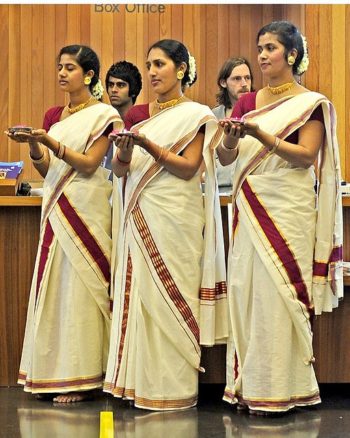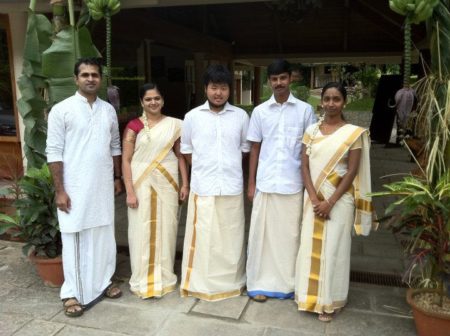Kerala Traditional Costumes
Kerala Traditional Costumes:
Kerala’s tradition and culture influence neighbouring states, like Tamilnadu and Karnataka. Kerala’s traditional costumes are straightforward and attractive. Generally, they wear white or off-white costumes. On wedding occasions, they wear different red-based colours. Kerala people are a combination of Hindus, Muslims and Christians. They wear dresses according to their religious faith. The people wear dresses respectively; commonly, the clothes are in cotton, which is needed for comfort during the hot and humid climate.
Kerala Traditional Costumes For women:

Women wearing dresses tradition is quite old, and people still prefer traditional attire. The traditional costumes are called Mundum Neriyathum. The mundu is the lower cloth, neriyathu is the blouse. The fabric is white, and the borders are dyed in various colours. And these borders are designed with multiple pictures. Most of the walls are in gold colour. The dress is like a sari. The dress borders, meaning the blouse, Sari, and mundu borders, are preferred to wear in the same gold colour. During the festival ceremonies, the colour of the blouses is divided according to the age and marital status of the women. The unmarried women wear green border blouses, and the married women wear red border blouses.
The women folks of Kerala wear the Sari, a trendy Kerala costume. The folk costumes are available in various colours with various designs. The colours are white and off-white, and others are equally popular.
According to the traditional changes, the costumes also changed in style and comfort. Recently, girls and women working in offices have preferred to wear Salwar Kameezes. Choosing to wear formal dresses is on the festival and other ceremonial occasions.
Kerala Traditional Costumes for Men:

The traditional dresses for the men are ancient; they wear white colour costumes, which are called the Mundu. In the olden days, men wore no cloth on the upper part of the body. The upper caste drapes a piece of material on the shoulder. The occurring changes in tradition and society, the men are wearing the shirt with white colour. The fabric is prepared with cotton, which makes comfort in hot climates. Kasavu Mundu is another dress that is worn in rural areas. The material is 3 to 4 metres long with silk borders.
Kerala state contains different religious and community people. The Muslim men wear a mundu in a different style. When they wear mundu, they keep a traditional cap on their head. The Muslim women wear a long dress and cover their heads with a cloth according to tradition.
The Christian women wear a mundu along with a particular type of blouse. The mundu is generally worn differently from that of Hindu women. One side of the mundu is folded in several parts and is placed at the back. The Christians’ costumes are similar to that of the Hindus.
Kerala Traditional Costumes of Brides:
Hindus: The bride is dressed in a mundu in the marriage ceremony. The clothes are in bright colours with different designs. The dresses are embroidered with rich colours. Kancheepuram sari is the most preferred Sari to wear on auspicious days. We can see Kunda and zardozi working on the bride’s Sari. The standard colours are red, maroon, orange and magenta; all are bright. Commonly men wear white coloured mundu.
Muslims: The bride wears a silk sari with bright colours. The dupatta forms the headdress, and golden lace is also attached. The costumes are richly designed with embroidery. Men wear white coloured mundu and shirt.
Christian: The bride wears a white dress during the wedding ceremony. At present, the brides prefer to wear white gowns. White is the symbol of purity. Men wear shirts and trousers or shirts. There are no restrictions on the men on the wedding day.
Saris:
People of Kerala wear traditional costumes, like Kancheepuram silk and Benaras silk, on special occasions. A conventional state dress is a half Sari consisting of a short blouse, a full skirt and a shawl.
With the traditional changes in society, many changes are occurring in dress-wearing. Women prefer salwar kameez; men wear shirts, t-shirts, trousers and jeans.